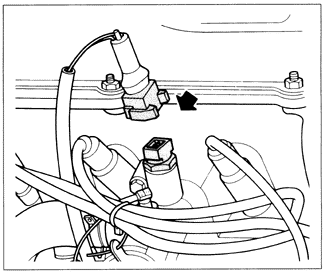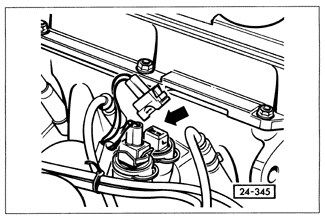4.1 Ignition Timing
Correct ignition timing is essential to proper engine performance. Checking and adjusting ignition timing is an important part of any engine tune-up. Ignition timing also needs to be adjusted whenever the distributor has been removed or taken apart, and whenever the camshaft drive belt has been adjusted or replaced.
Ignition timing has a significant effect on engine exhaust emissions. Ignition timing should always be adjusted in conjunction with idle mixture-the carbon monoxide (CO) level in the exhaust-and idle speed. See FUEL SYSTEM-GASOLINE.
Since accurate CO measurement and adjustment requires special skills and equipment, most do-it-yourselfers are advised to leave these adjustments to an authorized Volkswagen dealer service department or other qualified repair shop, to ensure compliance with exhaust emission regulations as well as maximum performance.
To check basic ignition timing:
(CIS, CIS-E, and CIS-E Motronic cars)
| 1. | On cars with manual transmission, use a 27 mm hex wrench to remove the plastic plug from the timing check hole at the top of the transaxle bellhousing. |
NOTE-
The entire plug must be removed. The small center plug is for use with a special timing indicator used by Volkswagen dealer technicians.
|
| 2. | With the ignition off, connect a tachometer and timing light to the battery positive (+) terminal and to the coil negative (-) terminal 1, according to the instrument manufacturers' instructions. |
CAUTION-
Do NOT allow terminal 1 of the ignition coil to be shorted to ground when connecting test equipment, as this will cause failure of the Motronic control unit.
|
| 3. | Start the engine and allow it to fully warm up. Oil temperature should be at least 140°F (60°C) on all except CIS-E Motronic cars, and at least 176°F (80°C) on CIS-E Motronic cars. The radiator cooling fan should cycle on and off at least once, indicating that the engine is up to normal operating temperature. |
NOTE-
 | On GX and MZ engines with the basic TCI-h system, the vacuum hose should remain connected to the distributor's vacuum advance diaphragm unit when checking ignition timing. |
 | On CIS-E Motronic cars, make sure the idle switch on the throttle housing is in the closed position. |
|
| 4. | With the engine idling, aim the timing light at the timing check hole in the bellhousing. The timing mark on the flywheel should appear adjacent to the pointer in the hole as shown in Fig. 4-4. |
WARNING-
Keep hands and other objects clear of the radiator cooling fan. The fan may start at any time, even when the ignition is switched off.
|
NOTE-
The basic timing indications are only valid when engine idle speed is within specifications. See FUEL SYSTEM-GASOLINE.
|
| Fig. 4-4. | Timing mark on flywheel aligned with pointer in timing check hole (top of bellhousing). |

|
| 5. | If ignition timing is within specifications, switch off the ignition and disconnect the test equipment. |
To check basic ignition timing:
(Digifant cars)
| 1. | On cars with manual transmission, use a 27 mm hex wrench to remove the plastic plug from the timing check hole at the top of the transaxle bellhousing. |
NOTE-
The entire plug must be removed. The small center plug is for use with a special timing indicator used by Volkswagen dealer technicians.
|
| 2. | With the ignition off, connect a tachometer and timing light to the battery positive (+) terminal and to the coil negative (-) terminal 1, according to the instrument manufacturers' instructions. |
CAUTION-
Do NOT allow terminal 1 of the ignition coil to be shorted to ground when connecting test equipment, as this will cause failure of the Digifant control unit.
|
| 3. | Disconnect the harness connector to the coolant temperature sensor as shown in Fig. 4-5 or Fig. 4-6. |
| 4. | Start the engine and allow it to fully warm up. Oil temperature should be at least 176°F (80°C). The radiator cooling fan should cycle on and off at least once, indicating that the engine is up to normal operating temperature. |
| 5. | Briefly raise the engine speed to about 2100 rpm and let it return to idle. Repeat the procedure three or four times. |
| Fig. 4-5. | Coolant temperature sensor connector (arrow) on 1987-1988 Digifant II system (engine codes RV and PF) disconnected for test. |

|
| Fig. 4-6. | Coolant temperature sensor connector (arrow) on 1989 and later Digifant II (engine codes RV and PF) and Digifant I (engine code RV) systems disconnected for test. |

|
NOTE-
Repeatedly raising the engine speed above 2100 rpm clears the control unit's memory and bypasses the normal hot-start, fast-idle function. This process must be repeated any time the engine is shut off and restarted during this procedure.
|
| 6. | With the engine running between 2000 and 2500 rpm, aim the timing light at the timing check hole in the transaxle bellhousing. The timing mark on the flywheel should appear adjacent to the pointer in the hole as shown above in Fig. 4-4. |
WARNING-
Keep hands and other objects clear of the radiator cooling fan. The fan may start at any time, even when the ignition is switched off.
|
| 7. | If ignition timing is within specifications, switch off the ignition and disconnect the test equipment. Reconnect the coolant temperature sensor harness connector. |
NOTE-
On Digifant I, disconnecting the coolant temperature sensor with the engine running will generate a fault code in the control unit memory, which must be erased. See FUEL SYSTEM- GASOLINE.
|
To adjust basic ignition timing:
(All models)
| 1. | With the ignition off, loosen the distributor hold-down bolt. On 16-valve engines, there are two. |
CAUTION-
The distributor should be just loose enough to be moved by hand, but tight enough that it can only be moved by deliberate effort. The distributor must not move by itself while the engine is running.
|
| 2. | Start the engine and recheck the timing. Adjust ignition timing by gradually turning the distributor housing until the timing mark, viewed with the timing light, meets with the specifications described above. See Fig. 4-4. |
| 3. | Stop the engine and, without moving the distributor, tighten the distributor hold-down bolt. On all except 16-valve engines, torque the bolt to 25 Nm (18 ft. lb.). On 16-valve engines, torque the bolts to 10 Nm (87 in. lb.). |
| 4. | Start the engine and recheck the ignition timing. Repeat the adjustment if necessary. |
| 5. | On Digifant II only, raise the engine speed to 3000 rpm 3 times, then check the idle speed and adjust it as necessary as described in FUEL SYSTEM-GASOLINE. |
| 6. | Turn the ignition off and remove the test equipment. On cars with manual transmission, replace the plastic plug in the timing check hole. |
NOTE-
On Digifant I, the Digifant control unit must be reset to its base setting after changing ignition timing. See FUEL SYSTEM-GASOLINE.
|
Ignition timing which varies continuously may be an indication of worn distributor shaft bearings. These bearings are not available as separate replacement parts. Repair is by replacement of the distributor housing only.
|


